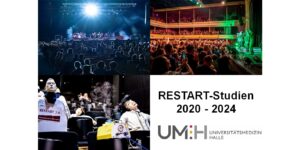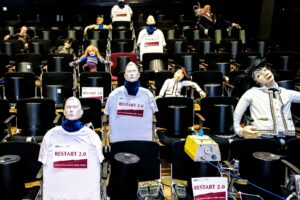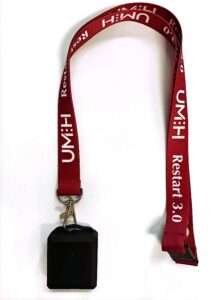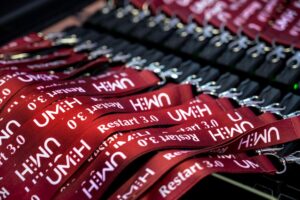Epidemiology & Nursing Research
Modelling
The aim of the project is to develop an agent-based model for the transmission of respiratory infections (using the example of COVID-19) for the state of Saxony-Anhalt. The model is intended to reflect the characteristics of the regional population as well as the geographical structures in a largely rural federal state. A particular focus is on regional mobility and the spread of infections within the state, as well as on potentially different dynamics of spread in the different regions. The project makes a direct contribution to pandemic preparedness by allowing scenarios of possible intervention measures to be played out.
- Jun.-Prof. Alexander Kuhlmann
- Prof. Rafael Mikolajczyk
Transmission Studies
Factors of natural infection protection against COVID in household members of infected persons
The aim is to investigate the transmission of respiratory infections in households. For this purpose, two prospective field studies with biosampling in complete households will be conducted. Recruitment will be from the participants of the DigiHero study (Germany-wide prospective cohort study on digital health research).
During the COVID-19 pandemic, the focus was on the transmission of SARS-CoV-2. During the study period from June to December 2022, all selected study participants were asked to contact the study team as soon as a person in their household tested positive for SARS-CoV-2. The households then received various study materials, including symptom diaries, questionnaires and dried blood kits. A total of 262 households with 662 people were evaluated. 58% of all household members became infected with a delay of three days in the household. The risk of infection was around 20% shortly after an infection or vaccination and rose to 80% within a year. The risk was reduced if the first person in the household only had mild symptoms or if preventive measures were observed. As the protective effect decreases significantly within a year, reinfections can be expected again and again in the coming cold seasons.
The University Medical Center Halle reported on this in the following press release:
Corona in households: Omicron protection against infection diminishes after a few months (in German)
The results were published in the journal “Infection”:
Klee B, Diexer S, et al. Household transmission of Omicron variant of SARS-CoV-2 under conditions of hybrid immunity-a prospective study in Germany. Infection. 2024 Jul 22. doi: 10.1007/s15010-024-02352-4.
In the fall/winter 2023/2024 cold season, the focus was on the transmission of various pathogens such as influenza viruses, RSV (respiratory syncytial virus) and coronaviruses in the household. In households where a first person showed symptoms of a respiratory illness (e.g. cough, sore throat or fever), a biosample was taken using a nasal swab. As the infection progressed in the household, the symptoms of all household members, if they fell ill, were documented in a diary and nasal swabs were also taken. The viral load and immune parameters are analyzed depending on the immune status prior to the infection and the respective exposure. The data obtained will be used, among other things, to determine parameters in mathematical models to estimate the pandemic risk and to determine the need for control measures. The evaluations are expected at the beginning of 2025.
- Prof. Rafael Mikolajczyk
Analysis of the adherence to measures
Adherence to preventive measures in emerging infectious disease
Measures for infection prevention are crucial in light of the recurring increase in infection numbers and challenges posed by new virus variants to contain the spread of infections. This applies not only to the COVID-19 pandemic. However, the effectiveness of these infection prevention measures depends significantly on the population’s adherence. Adherence is a complex phenomenon determined mainly by personal factors, socio-economic factors, external/environmental factors, and factors within the healthcare system. Key modifiable factors for adherence include knowledge, attitudes, and practices (KAP) regarding infection prevention. Understanding these processes enables targeted improvement of adherence within the context of the pandemic.
While there are existing data on KAP among selected cohorts related to specific infections (such as Covid-19 or HIV), a comprehensive analysis of underrepresented groups in the German context is lacking. This includes groups typically not participating in common online surveys, such as multimorbid older individuals and people in care homes. Measures to enhance adherence need to be more targeted and nuanced, as there cannot be a one-size-fits-all adherence-promoting intervention. Using mixed methods and network analyses, this study aims to investigate KAP in these vulnerable groups. Additionally, it will analyze the individual-level effects of the measures on well-being, psychological stress, and mobility.
- Prof. Tino Prell
Aerosol spread and indoor contact
RESTART-19, RESTART 2.0, RESTART 3.0

2020 – RESTART-19 (The risk of indoor sports and culture events for the transmission of COVID-19)
During the COVID-19 pandemic, this project was set up with the aim to analyze the risk of transmitting SARS-CoV-2 by droplets and aerosols during a seated indoor mass gathering events (MGEs). This was done by setting up an experimental seated indoor MGE event with german pop singer Tim Bendzko performing on August, 22nd 2020 (Fig. 1 & 2). The MGE was divided into three different hygiene scenarios. Scenario 1 was designed to reflect a pre-pandemic state. Scenario 2 applied moderate hygiene measures: the arena was divided into four quadrants. Participants were not allowed to change quadrants. Scenario 3 reflected a stronger contact reduction, with pairwise seating of participants and the implementation of a minimum distance of 1.5 m between the occupied pairs of seats (Table 1). Throughout this event, all contacts of the participants were tracked by special contact tracing devices (CTDs). In addition, two different ventilation systems were simulated which took different airflows and air exchange rates into account.
This study revealed that the mean number of measured contacts per participant in indoor seated events was nine persons. These can be reduced by appropriate hygiene practices. Also, the appliance of a suitable effective ventilation system in seated indoor MGEs is crucial to reduce the exposure to infectious aerosols. These two factors combined result in very small effects on the spread of a pandemic.

Table 1: Components of the hygiene practices in the three different scenarios.

Figure 1: German pop singer Tim Bendzko performing live for the RESTART-19 study.

Figure 2: Seated audience during the RESTART-19 concert
2022 – RESTART 2.0 (SARS-CoV-2 airborn infections in venues – a comparison of different ventilation ventilation strategies)
Restart 2.0 took a closer look at the heterogeneity of aerosol dispersion in different event spaces. For this purpose, 10 event locations were investigated simultaneously using CFD (Computational fluid dynamics) simulation and an experimental method with special dummies evaporating sodium chloride vapor (Fig. 3). The airborne transmission risk of venues with different room characteristics and ventilation concepts was examined. The effect of varying boundary conditions on the risk of infection was investigated, e.g. emitter position, occupancy rate, airflow rate, mitigation measures.

Figure 3: Artificial dummies emitting sodium chloride vapour. These dummies were placed between fully occupied audiences in different locations.
2024 – RESTART 3.0 (Assessing the role of mass gathering events (MGE) for the spread of the pandemic)
The third installment of the RESTART studies now aimed at the differences between a seated and standing audience. The primary goal of this trial was to figure out how many contacts do standing visitors have and how these differ from the seated audience. For this purpose, a concert was organized on February, 26th 2024 with the german pop band “die Prinzen” performing. This event was attended by 1300 visitors (Fig. 4). Half of the audience was seated and half was standing. For contact measurement, each visitor had been equipped with a contact tracing device (CTDs; already used in the RESTART-19 study; Fig. 5 & 6). During the course of the venue, the participants had to wear these devices to ensure a constant recording of the contact time with other visitors. All contact information was stored on the CTDs and later read out and analyzed. We investigated two distinct scenarios: seated and standing. Within each scenario, we computed the total number of contacts throughout the concert duration. Furthermore, we partitioned the concert into three phases: Pre-concert, Concert, and Post-concert, and determined the number of contacts for both scenarios across these phases.
Preliminary results suggest the standing scenario having higher overall number of contacts throughout the concert than the seated scenario. Highest numbers occurred in the standing scenario during the concert phase compared to the pre- and post-concert phases. Conversely, the seated scenario demonstrated relatively consistent number of contacts across the various concert phases. Up to this point, these analyses just represent preliminary data. Further analyses will be necessary to fully understand the role of contacts during MGEs. This then should enable more precise modelling and statements about the effectiveness of various containment measures during possible future pandemics.

Figure 4: “Die Prinzen” performing at RESTART 3.0 in the Steintor Varieté Halle (Saale)

Figure 5: Contact tracing device with lanyard; participants had to wear these around their necks during the whole venue.

Figure 6: CTDs in loading caste with attached lanyards
The RESTART studies investigated aerosol dispersion and contact courses separately. For aerosol distribution a static situation for the exposed visitors was assumed. However, in real life people move around within a room and therefore the aerosol exposition changes over time. In this Coprep project we aim to overcome this limitation, even though we will conduct the trial in a smaller dimension. Within a restaurant or bar all visitors will be equipped with out contact tracing devices already used in earlier experiments. In addition, the restaurant will be prepared with a radio system which allow the exact positioning tracing of visitors over time by rapid triangulation. In addition, a CFD of the restaurant is conducted and the aerosol distribution of infected “virtual visitors” is mapped. In the last step both data will be superimposed and the infection probability for each visitor will be calculated.
The RESTART studies were conducted in big event locations, such as the Quarterback Immobilien Arena Leipzig (RESTART-19), Oper Halle (Saale) (RESTART 2.0), or Steintor Varieté Halle (Saale) (RESTART 3.0). A crucial part was to investigate the transmission of SARS-CoV-2 in closed rooms.
In contrast to these studies in MGEs, another subproject pays particular attention to office and gastronomy spaces to develop better models for the transmission of this respiratory virus. The aim in these fields of research is also to be prepared for future pandemics.
- Dr. Stefan Moritz
- Prof. Rafael Mikolajczyk
Outbreak control in retirement and nursing homes
Protocol-led data collection of pandemic events for the coordinated handling of nursing homes in Saxony-Anhalt (Progeleit)
Immediately at the beginning of the SARS-CoV-2 pandemic, there was a demand for the nursing home setting to create a solid clinical-epidemiological database in order to enable empirically sound and evidence-based action. The approach of the RKI’s surveillance system reached its clearly recognizable limits here and was not very suitable for serving as a source of information for the setting or for drawing clinically relevant conclusions about the effects of the pandemic and the measures taken to control it on resident-relevant health outcomes, causes of death, social participation and dignity violations.
In preparation for the next pandemic threat situation in Saxony-Anhalt – with its almost 700 nursing homes and more than 29,000 residents – a study protocol will be developed that can be activated immediately, defining proven approaches to data collection (such as sentinel, registers, surveys) on a consented set of outcome variables and outlining data protection, flow, analysis, processing and feedback to decision-makers. The methods used include literature syntheses, focus groups and expert interviews. Finally, the protocol is coordinated with relevant stakeholders to ensure its acceptance and feasibility.
- Prof. Gabriele Meyer
- Dr. Almuth Berg
Recommendations for decisions in nursing homes
Proactive support of pandemic-related decisions in longterm care (ProSuPaD)
The aim of the project is to develop and provide recommendations for action to support pandemic-related decision-making processes for managers of inpatient long-term care facilities.
The methods used include literature syntheses, online surveys, expert interviews and milestone workshops. The formulated and evaluated recommendations for action for managers of inpatient long-term care facilities will be applicable nationwide.
- Dr. Anja Bieber
Logistics of the health departments
Problem analysis and potential analysis for increasing pandemic resilience in health departments
In order to increase pandemic resilience in Saxony-Anhalt, health departments must expand in a crisis-proof manner on an institutional level. To realize this, we first have to identify specific needs, demands, and issues in local health departments.
Data from departments of health is going to be gathered by means of a mixed methods approach. Specifically, experiences of health department employees are to be recorded using questionnaires.
In addition, expert interviews will be conducted in selected departments to further delve into the topic and build a better understanding of the subject.
- Dr. Anja Knöchelmann
Target group specific communication on modelling studies
During the SARS-CoV-2 pandemic, there was a great social need for information on a variety of topics, e.g. vaccination, infection control and pandemic control structures. A high proportion of respondents use traditional media (TV 70.6%; radio 58.5%; magazines 32.7%) as a source of information. Media consumption has increased with the onset of the pandemic in Germany, which underlines its relevance in risk communication. However, selected analyses of media reports have shown that, from a health science perspective, risk communication is inadequate. Criteria for suitable forms of presentation that allow a realistic assessment of risks have been adequately described. It is less clear how the quality of evidence and statistical uncertainties should be communicated. The uncertain data situation is a particular challenge under pandemic conditions. In particular, statements on the risk of infection or the effectiveness of infection control measures are largely based on modeling studies. Experts see it as a major challenge to adequately communicate the associated uncertainties to the public, but also to political decision-makers.
In a qualitative feasibility study, (1) criteria will be defined that enable an assessment of the reliability of data from modeling studies; (2) proposals for communicating uncertainties will be developed and (3) target group-specific tools (information templates and explanatory videos) will be provided to improve risk communication. The development and piloting of the tools follows the UK MRC framework for complex interventions.
- Prof. Dr. Anke Steckelberg
Jun. Prof. Dr. Alexander Kuhlmann
Scoping Review
Scoping reviews on care in obstetrics and abdominal oncology surgery during the Covid-19 pandemic
The Covid-19 pandemic posed enormous challenges for obstetrics and oncological abdominal surgery and required adjustments through measures such as patient monitoring, social distancing, disinfection, vaccination and the use of protective clothing. These changes, as well as uncertainties in the application of new standards of care, ethical dilemmas, work restrictions and crisis-related problems, significantly affected the working conditions of obstetric and abdominal oncology surgery staff. Despite their critical importance, the impact of the Covid 19 pandemic on the structural and psychological aspects of healthcare staff in obstetrics and abdominal oncology surgery has not yet been fully investigated.
The main aim of the two scoping reviews is to provide an up-to-date and interdisciplinary overview of how the Covid-19 pandemic has affected working conditions for obstetric and abdominal oncology surgery staff. Our inclusion criteria include qualitative and quantitative study types and focus on the perspective of professional healthcare actors.
We will provide an overview of the themes identified and provide a narrative synthesis of the findings. The findings will provide evidence for strategies to address future health crises.
The results were published in the journal “The American Journal of Surgery”:
Madi M, Heise M, Rieder L, Mattern E, Ronellenfitsch U, Steckelberg A. Effects of the COVID-19 pandemic on the providers of oncological abdominal surgery services- a scoping review. Am J Surg. 2025 Mar;241:116068. doi: 10.1016/j.amjsurg.2024.116068. Epub 2024 Nov 5. PMID: 39522445.
- Prof. Dr. Anke Steckelberg
Midwifery and oncological abdominal surgery services during a pandemic
Cross-sectoral testemonials from midwives, nurses, and medical practitioners on the quality of obstetrics during the pandemic.
Nationally and internationally, the treatment of COVID-19 positive patients was prioritized within the healthcare system during the COVID-19 pandemic. This prioritization may have had negative effects, so-called “collateral damage”, on care areas that were not affected by the pandemic disease, such as obstetrics and oncological surgery in this case.
Fewer check-ups, personal support services, dealing with infected clients and many other factors may have led to uncertainty and anxiety among obstetric and oncological surgery staff. How the staff themselves experienced these exceptional situations during the COVID-19 pandemic has not yet been sufficiently described.
The obstacles, burdens, but also resources and possibly the motivation of obstetrics and oncological surgery staff during the COVID-19 pandemic will be analyzed and presented separately.
The qualitative research design will be implemented with focus group discussions and, if necessary, individual interviews. The obstetrics and oncological surgery staff can explore their experiences during the COVID-19 pandemic in a protected environment. An interpretative hermeneutic research approach was chosen to understand the phenomena mentioned by the interviewees.
The explorations from the perspective of those directly involved in care can make an important contribution to learning lessons from the past/current pandemic for future health crises.
- Prof. Dr. Anke Steckelberg
Mask dermatitis
Pathogenetic factors of mask dermatitis and development of specific prevention strategies
As part of the pandemic hygiene measures, the wearing of medical mouth and nose protection (MMNP) and subsequently filtering face pieces (FFP2) masks was widely propagated and implemented as one of the basic preventive measures. There is no question that the tight sealing of the mouth-nose region achieves effective and efficient prevention of SARs-CoV2 infection. From a dermatological point of view, the occlusion phenomena lead to a strong change in the environment, which is accompanied by a rise in temperature, hyperhydration of the horny layer and an increase in pH. The secondary consequences of the milieu change have not yet been investigated, but it is assumed that a diversity switch in the cutaneous microbiota leads to decompensation of the microbiological barrier and subsequent inflammatory phenomena known as mask dermatitis. The literature shows that the prevalence of mask dermatitis correlates directly with the daily wearing time (2 hours = 49.5%, 4 hours = 58.6% and 10 hours = 62.5%), so that a direct connection with the occlusive phenomena and the clinical phenotype is assumed to be well-founded and very likely. Since previous strategies and recommendations of the professional societies for the prophylaxis of mask dermatitis are essentially aimed at reconstituting the physicochemical barrier and experience has shown that they have little effect, the present project aims to specifically investigate the influence of FFP2 masks on the cutaneous microbiome. In addition to skin function measurements and culture methods, 16s rRNA targeted sequencing will also be used to determine diversity. If a dysbiosis (change in diversity) can be detected, this data will be used to develop new preventive strategies.
- adjunct Prof. Johannes Wohlrab
Tumor surgery
Data analysis
Due to extremely high utilization of intensive care units and regular wards and high frequency of sickness or quarantine among medical staff, operating theater capacity had to be drastically reduced in many hospitals during the COVID-19 pandemic waves. This resulted in delayed operations for oncological diseases with potential consequences on curability, disease-free and overall survival of patients. In this subproject, data from the global COVIDSurg Collaboration as well as our own data from the University Hospital Halle (Saale) and the BG Klinikum Bergmannstrost Halle (Saale) on the volume of surgeries and postponements of surgeries during the COVID-19 pandemic waves will be evaluated. Using these data, modeling will be carried out to show how operations should be prioritized during a pandemic when operating room and intensive care capacity is limited, so that the population suffers as few health disadvantages as possible with regard to surgical care for oncological diseases.
- adjunct Prof. Ulrich Ronellenfitsch
Antonia Stengler
Death certificates
Data analysis
Further information will follow shortly.
- Prof. Rüdiger Lessig
- Prof. Claudia Wickenhauser
Empirical and ethical analysis
During the COVID-19 pandemic waves, decisions were made in many hospitals and other healthcare facilities regarding the allocation of resources in favor of care for patients with coronavirus. Accordingly, health-related measures for patients with other diseases were reduced.
As part of this sub-project, various options for resource allocation will be examined on the basis of the data collected in CoPreP in different areas of care and in conjunction with ethical-normative analyses. The results will form the basis for recommendations for action on the empirically and ethically justified distribution of scarce resources in a pandemic and comparable crisis situations.
- Prof. Jan Schildmann
- Dr. Sabine Sommerlatte
Creation of recommendations for action
Nationally and internationally, the treatment of COVID-19 positive patients was prioritized within the healthcare system during the COVID-19 pandemic. However, this prioritization may have had a negative impact on patients who were not directly affected by the pandemic disease. One example of this is oncology operations that were postponed due to a relative lack of capacity in hospitals.
In order to be able to better guarantee health-related measures in future pandemics and comparable crisis situations, it is important to formulate practical recommendations for prioritizing healthcare in the event of a pandemic.
The aim of this sub-project is to develop evidence-based and ethically justified recommendations for prioritizing measures in various areas of healthcare in times of pandemics or other restrictions on healthcare resources based on the data analyses of the data collected in CoPrep.
These recommendations for action are not aimed directly at combating the pandemic, but at accompanying healthcare measures in order to maximize the health benefits for the population and avoid possible negative effects, so-called “collateral damage”.
- adjunct Prof. Ulrich Ronellenfitsch
Piloting of recommendations for action
The aim of the sub-project is to test the recommendations for action for feasibility and acceptance with obstetrics and tumor surgery staff.
The qualitative research design will be implemented with focus group discussions and, if necessary, individual interviews. The obstetrics and oncological surgery staff discuss the recommendations for action with regard to comprehensibility, acceptance and implementation. The data is evaluated using content analysis
Once the recommendations for action have been tested, they will be available as relevant tools for those directly involved in the provision of care in order to be able to act in pandemic situations. The recommendations for action can also be incorporated into the curricula.
- Prof. Dr. Anke Steckelberg